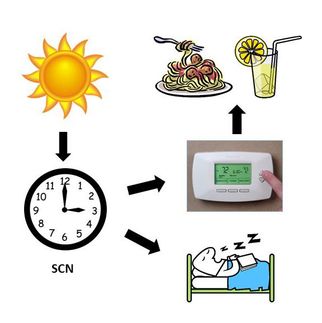Molecular features of the circadian clock system in fruit flies
Studies of mutant fruit flies reveal how both photoreceptors and the visual system influence circadian clock neurons in response to changing light-dark cycles. The results are reported in the Journal of Neuroscience give new insights into sleep disorders including jet-lag.
Our bodies can respond to shifts in day and night patterns by reprogramming our so-called ‘circadian clock’ – a molecular system which responds to light-dark cycles (LD cycles). Now, Taishi Yoshii and Kenji Tomioka at the Graduate School of Natural Science and Technology, Okayama, in collaboration with scientists in Germany, have revealed how protein photoreceptors called ‘cryptochromes’ (CRY), together with the visual system, influence circadian clock neurons in Drosophila, or fruit flies.
Circadian clock neurons can be divided into two groups; morning neurons (M) and evening neurons (E). CRY proteins are expressed in most clock neurons and send signals in response to light, but the specific role of CRY in different types of clock neurons is unclear.
Yoshii and colleagues generated mutant fly-lines, some without CRY and others expressing CRY in different neuron subsets. They also wanted to determine the influence of the eyes and visual system signals on the neurons. Their aim was to test the flies’ ability to synchronise to changes in LD cycles, a process known as LD entrainment.
They exposed the flies to an 8-hour delay in the 16-hour/8-hour LD-cycle. Control flies responded to the shift within a day, but those flies without CRY, and without eyes, were incapable of any LD entrainment. Mutant flies with E neurons were able to re-entrain, but their response was slow. The team discovered this entrainment ability was due to a molecular cycling process involving a protein called par domain protein 1 (PDP1), which is triggered by the visual input pathways, independent of CRY.
When the team then expressed CRY in the E neurons the LD entrainment process sped up considerably. If CRY was expressed only in M neurons, no LD entrainment occurred. The results indicate that CRY expression in E neurons is important to LD entrainment and that molecular cycling of PDP1 supports this process.
Original publication
Original publication
T. Yoshii, C. Hermann-Luibl, C. Kistenpfennig, B. Schmid, K. Tomoika, & C. Helfrich-Förster; "Cryptochrome-dependent and –independent circadian entrainment circuits in Drosophila."; The Journal of Neuroscience 35 (15) 2015, 35(15):6131-6141・6131.
Organizations
Other news from the department science

Get the life science industry in your inbox
By submitting this form you agree that LUMITOS AG will send you the newsletter(s) selected above by email. Your data will not be passed on to third parties. Your data will be stored and processed in accordance with our data protection regulations. LUMITOS may contact you by email for the purpose of advertising or market and opinion surveys. You can revoke your consent at any time without giving reasons to LUMITOS AG, Ernst-Augustin-Str. 2, 12489 Berlin, Germany or by e-mail at revoke@lumitos.com with effect for the future. In addition, each email contains a link to unsubscribe from the corresponding newsletter.


















































